Golestan Palace
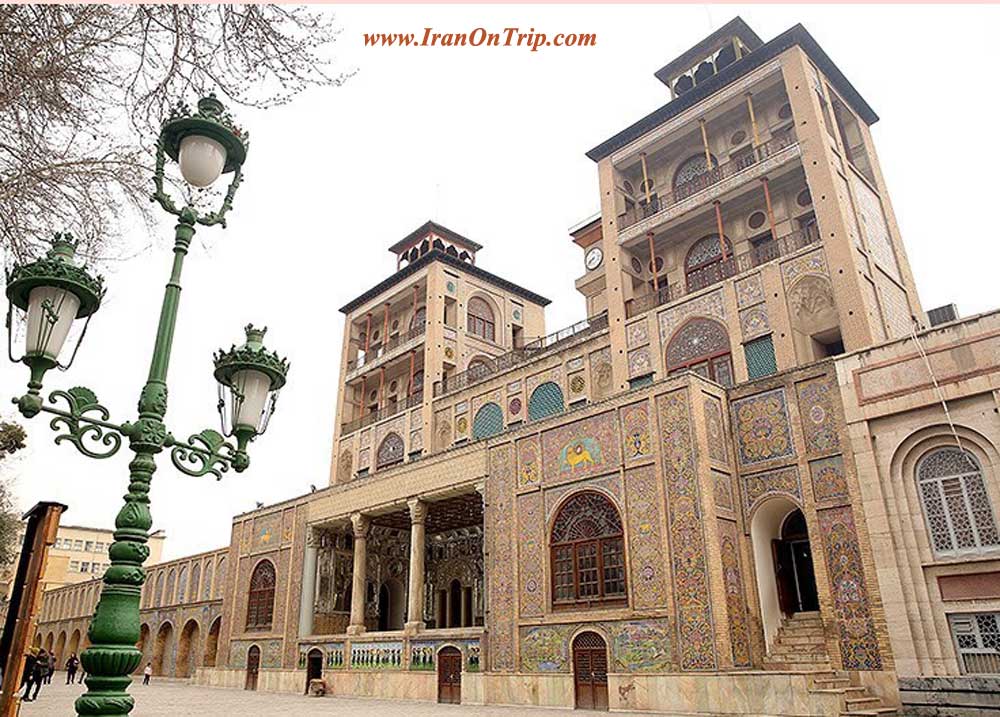
Located in Tehran (a city of Tehran province)
Golestan Palace (Persian: کاخ گلستان) pronounced "Kakheh Golestan" is the former royal Qajar complex in Iran`s capital city.The oldest of the historic monuments in Tehran, a world heritage,the Golestan Palace (also Gulistan Palace) (The Rose Garden Palace) belongs to a group of royal buildings that were once enclosed within the mud-thatched walls of Tehran’s Historic Arg (citadel).
History
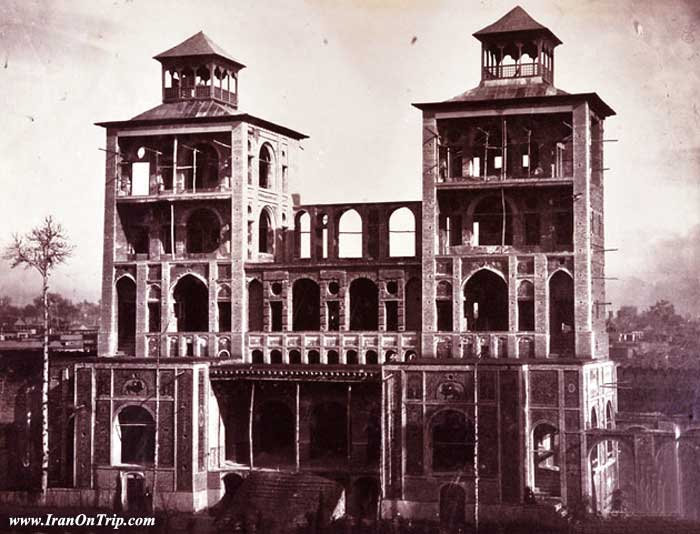
The Arg was built during the reign of Tahmasp I (r. 1524-1576) of the Safavid dynasty (1502–1736), and was later renovated by Karim Khan Zand (r. 1750-1779). Agha Mohamd Khan Qajar (1742–1797) chose Tehran as his capital. The Arg became the site of the Qajar (1794–1925). The Court and Golestan Palace became the official residence of the royal Qajar family. The palace was rebuilt to its current form in 1865 by Haji Abol-hasan Mimar Navai.During the Pahlavi era (1925–1979) Golestan Palace was used for formal royal receptions and the Pahlavi dynasty built their own palace at Niavaran. The most important ceremonies held in the Palace during the Pahlavi era were the coronation of Reza Khan (r. 1925-1941) in Takht-e Marmar and the coronation of Mohammad Reza Pahlavi (r. 1941-deposed 1979) in the Museum Hall.In between 1925 and 1945 a large portion of the buildings of the palace were destroyed on the orders of Reza Shah who believed that the centuries old Qajar palace should not hinder the growth of a modern city. In the place of the old buildings modern 1950s and 1960s style commercial buildings were erected.
Palaces
Golestan Palace Complex consists of 17 palaces, museums, and Halls. Almost all of this complex was built during 200 years of Qajar kings ruling. These palaces were used for many different occasions such as coronation and other important celebrations.
Takht Marmar

The spectacular terrace known as Takht-e Marmar (Marble Throne) was built in 1806 by order of Fath Ali Shah Qajar (r. 1797-1834). Adorned by paintings, marble-carvings, tile-work, stucco, mirrors (Mirrorwork), enamel, woodcarvings, and lattice windows; the throne embodies the finest of Iranian architecture. The Marble Throne is one of the oldest buildings of the historic Arg. The existing throne, which is situated in the middle of the terrace (iwan), is made of the famous yellow marble of Yazd province.The throne is made of sixty-five pieces of marble and was designed by Mirza Baba Naghash Bashi (head painter) of the Qajar court. Mohammad Ebrahim, the Royal Mason, oversaw the construction and several celebrated masters of the time worked on the execution of this masterpiece. The architectural details and other ornaments of the terrace (iwan) were completed during the reigns of Fath Ali Shah and Nasser - ol- Din Shah (r. 1848-1896).Coronations of Qajar kings, and formal court ceremonies were held on this terrace (iwan). The last coronation to be held at Takht-e-Marmar was the coronation of, the self-proclaimed King, Reza Khan Pahlavi in 1925.
Khalvat Karim Khani

Dating back to 1759, this building was a part of the interior residence of Karim Khan Zand. The basic structure of the Khalvat-e-Karim Khani is similar to Takht-e-Marmar. Like the latter, it is a terrace (iwan). There is a small marble throne inside the terrace. The structure is much smaller than Takht-e-Marmar and it has much less ornamentation. There was once a small pond with a fountain in the middle of this terrace. Water from a subterranean stream (the king’s qanat) flowed from the fountain into the pond and was later used to irrigate the Palace grounds.
Nasser-ol-Din Shah was fond of this corner of Golestan Palace. He is said to have spent much time here in rest and repose– smoking his water pipe in quite reflection. In fact, some believe that it was he who dubbed the structure Khalvat (nook). It seems extraordinary, but the valuable gravestone of Nasser-ol-Din Shah finally found its way to this quite corner of the Palace after being misplaced for sometime. This marble stone with a craved image of Nasser-ol-Din Shah is indeed a site to behold.
Hoze Khaneh
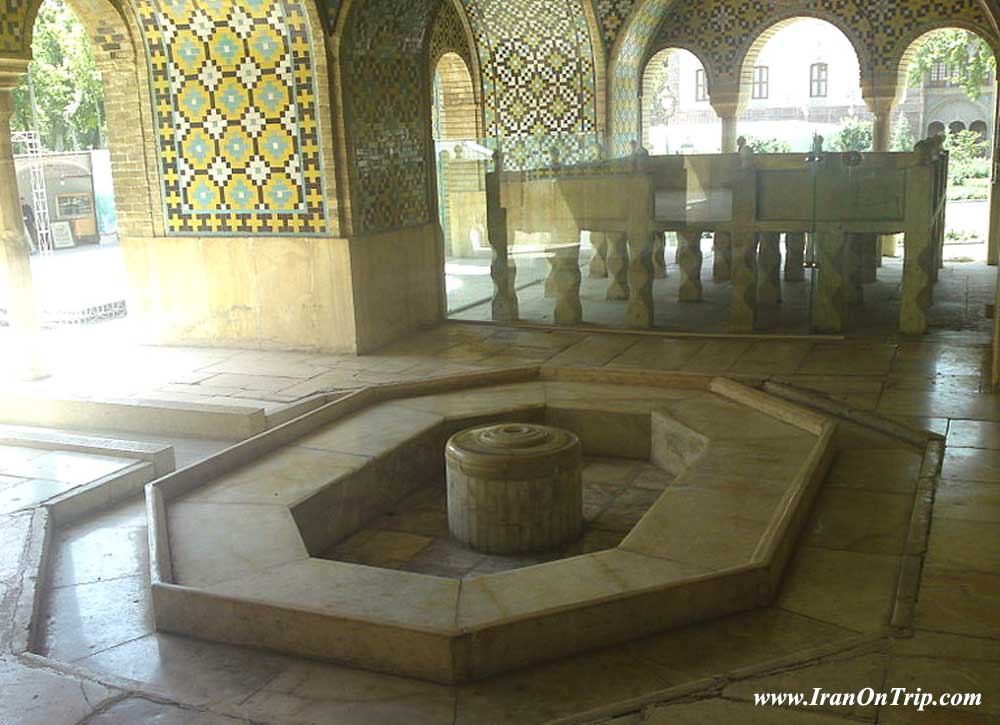
Works of European painters presented to the Qajar court are housed in the Hoze Khaneh.
The Hoze Khaneh was used as a summer chamber during the Qajar ear. A special cooling system pumped water form a subterranean system of streams (qanats) – in this case the king’s qanat – into small ponds inside the chambers. Hose means pond, thus the name Hose Khaneh. The system was designed to pass through as many summer rooms as was necessary. The water was then channeled outside to irrigate the royal gardens. Due to the harmful effects of humidity, this system is no longer in use.
Negar Khaneh
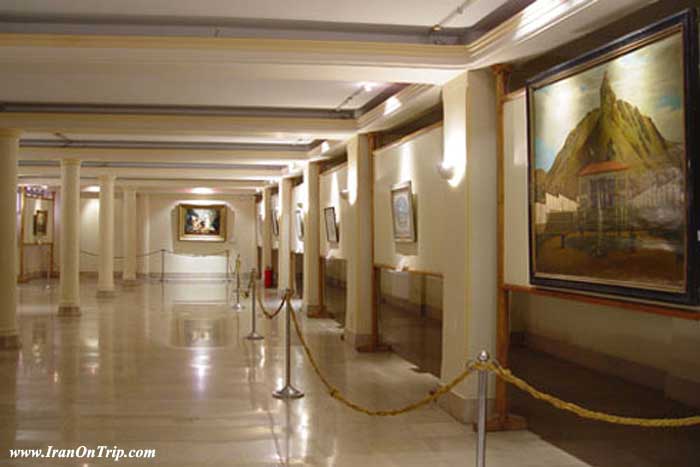
Nasser-ol-Din Shah was very impressed by the exhibition of artifacts and valuable objects at European museums during his second European tour around 1872. He arrived back in Tehran intent on building a museum hall to exhibit paintings, royal jewels, and other royal artifacts.
The original collection of the museum hall is now scattered among Tehran’s many museums. However, the paintings of the royal court are now kept at the Golestan Palace – with the European paints housed in the Hose Khaneh and the works of Iranian painters housed in the Negar Khaneh (the Gallery). Meant to show the evolution of painting in Iran during the Qajar era, the works of Iranian painters are exhibited in two sections. Housed in the southern part of the Negar Khaneh are the works of early Qajar masters such as Mirza Baba, Mehr Ali Afshar, Ali Akbar Khan Mozaien-ol-Douleh, Aboul Hassan Sani (Sanie-ol-Molk) who was Kamal-ol-Molk’s uncle.
The northern Negar Khaneh, was the seat of the Royal Guard during the time of Mohammad Reza Pahlavi. The northern hall underwent substantial renovations in 1995 and now houses the works of later masters of the Qajar era such as Mahmoud Khan Saba (Malek-ol-Shoara), Mohammad Gafari Kashani (Kamal-ol-Molk), Mehri, Mosa Momayez.
Talar Berelian

Talar-e Berelian (Hall of Brilliance) was named so for it is adomed by the brilliant Mirrorwork of Iranian artisans. The Hall was build by Nasser-ol-Din Shah build to replace another hall called Talar Bolour (Crystal Hall). Built by Fath Ali Shah the Bolour Hall had been laid waste by the damp. The Berelian Hall is famous for its mirror work and chandeliers. An oil painting by Yahya Khan Sanie-ol-Molk Ghafari, showing the decorations of this hall before renovations carried out by Mozafar-ol-Din Shah (r. 1896-1907). exists in the Golestan Palace.
In the Ethnography gallery in Horsham Museum, Horsham, United Kingdom an Iranian Tile is displayed. The tile, according to the former Deputy Minister of Culture and Higher Education of Iran, Dr Mehdittodjat, comes from the Golestan Palace built around 1810-20, one of the foundation buildings of Teheran. It comes from the entrance to the Salone Beriliyon (brilliant diamond) room and was probably a reject or it may have been retrieved from the rebuilding of the palace in the period 1867-92. It was found, smashed beneath a gatepost in Shipley by Mr & Mrs Ayling, who kindly donated it to the Museum. The plaque has been set in plaster and unfortunately not all the glazed decoration survived.
Museum Of Gifts
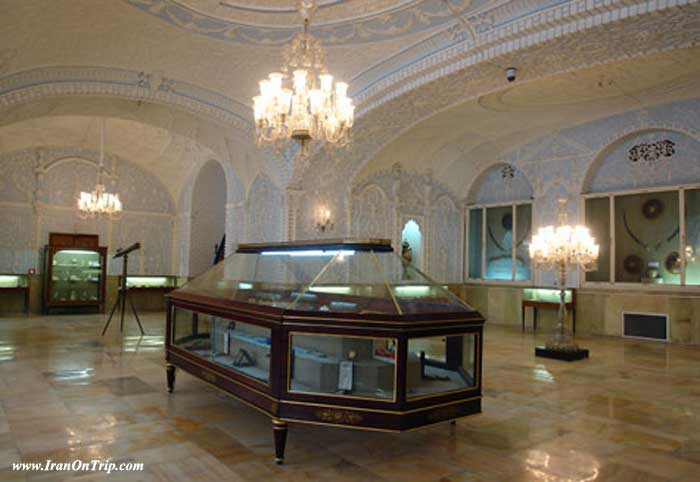
This building is located under the Salam Hall or Museum. It is indeed a part of the first Iranian museum, which was built by Mohamad Ebrahim Khan Memar Bashi.
In Nasser-0l-Din shah’s period, this building was used as a warehouse for the china and silverware, which was dedicated to Qajar kings.
In the Pahlavi period, this warehouse was turned in to a museum to expose the rare gifts, which was given to the Qajar kings.
Right now in addition to the gifts, some rare objects are kept in this museum, some of them are as follows: 1- Helmet of king Esmail Safavid. 2- Bow and arrows of King Nader. 3- Armband of Fath Ali Shah. 4- The collection of Qajar Seals. 5- Aga Mohamad khan’s crown. 6- A decorated ostrich egg.
Talar Zoroof

This building replaced the Narenjestan building in the north of Adj Hall or sofre Khaneh. All the chinaware that were dedicated to Qajar kings by the European kings were taken to this room and was arranged in show cases which were built for this purpose.
All the chinaware that exists in this room is rare and beautiful. Among them these are the most exceptional:
1- The chinaware that shows the Napoleonic wars dedicated by Napoleon the first.
2- The chinaware dedicated by King Nicoli the first.
3- Chinaware studded with gems and jewels dedicated by Queen Victoria.
4- The chinaware which was dedicated by King Vilhelm to the Iranianan crown prince.
5- A set made by Melacit stone dedicated by Alexandre the third.
Talar Adj
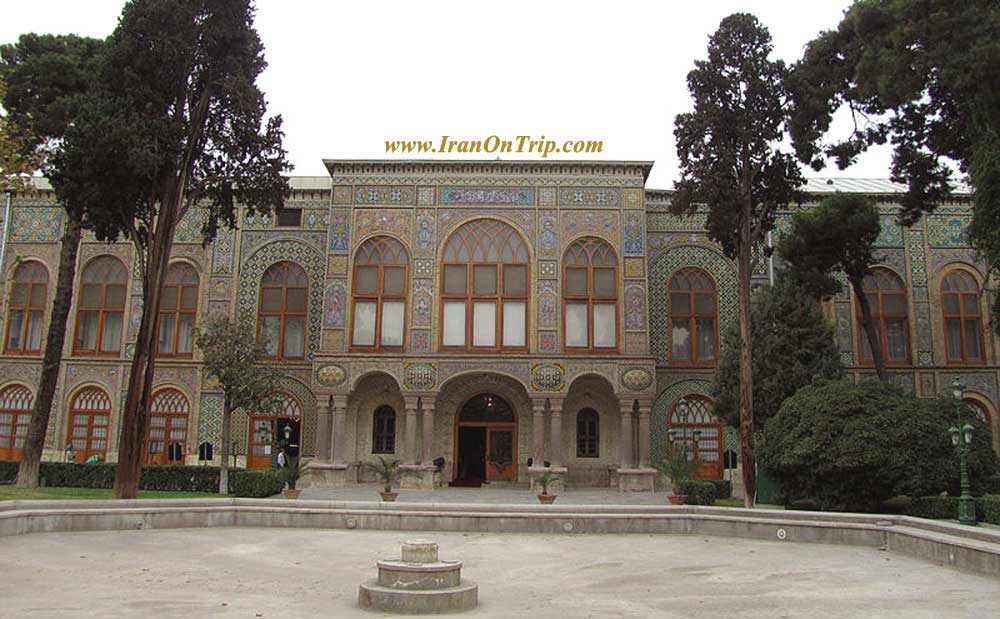
Talar-e Adj (Hall of Ivory) is a large hall used as a dining room. It was decorated with gifts presented to Nasser-ol-Din Shah by European monarchs.
Among the Golestan Palace collection, a watercolor by Mahmoud Khan Malek-ol-Shoara, shows the exterior view of this hall during the Qajar period.
Talar Aineh
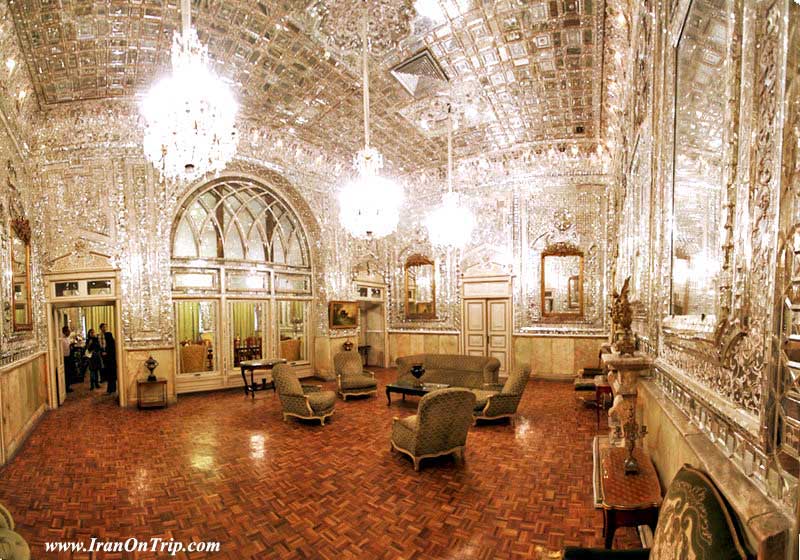
Talar-e Aineh (Hall of Mirrors) is the most famous of the Palace hall. This relatively small hall is famous for its extraordinary mirror work. The Hall was designed by Haj Abdoul Hossein Memar bashi (Sanie-ol-Molk).Yahaya Khan Moetamed-ol-Molk,the Minister of Architecture,acted as consultant to the designer.
Talar Salam
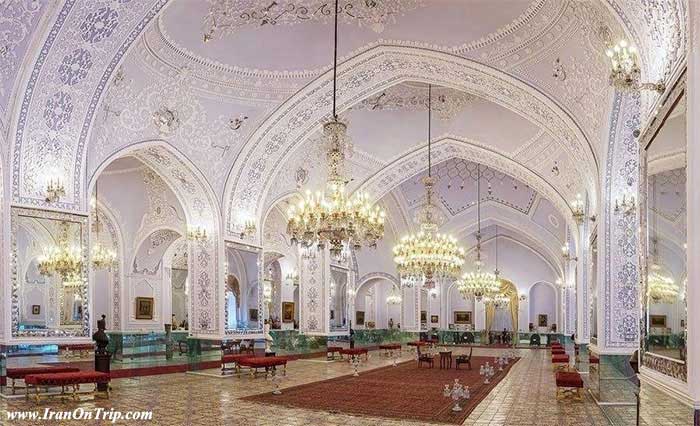
Talar Salam (Reception Hall) was originally designed to be a museum. After the Takht-e-Tavoos (Iranian’s famous Jeweled Peacock Throne) was moved to the Royal jewels collection at the Central Bank, this hall was designated to hold special receptions in the presence of the king, hence the name Talar Salam.Tourists and envoys from European courts received in the Arg during the reign of Nasser-ol-Din Shah, spoke of this outstanding hall comparing it to its European counterparts.This hall has exquisite mirrors work. The ceiling and walls are decorated with plaster molding. The floors are covered with mosaic.During the reign of Nasser-ol-Din Shah, this hall was used to exhibit Iranian and European paintings alongside gifts presented to the Iranian court. Royal jewels were also exhibited inside glass cases. These jewels are now housed at the Royal Jewels Museum of the Central Bank.
Shams-ol-Emareh
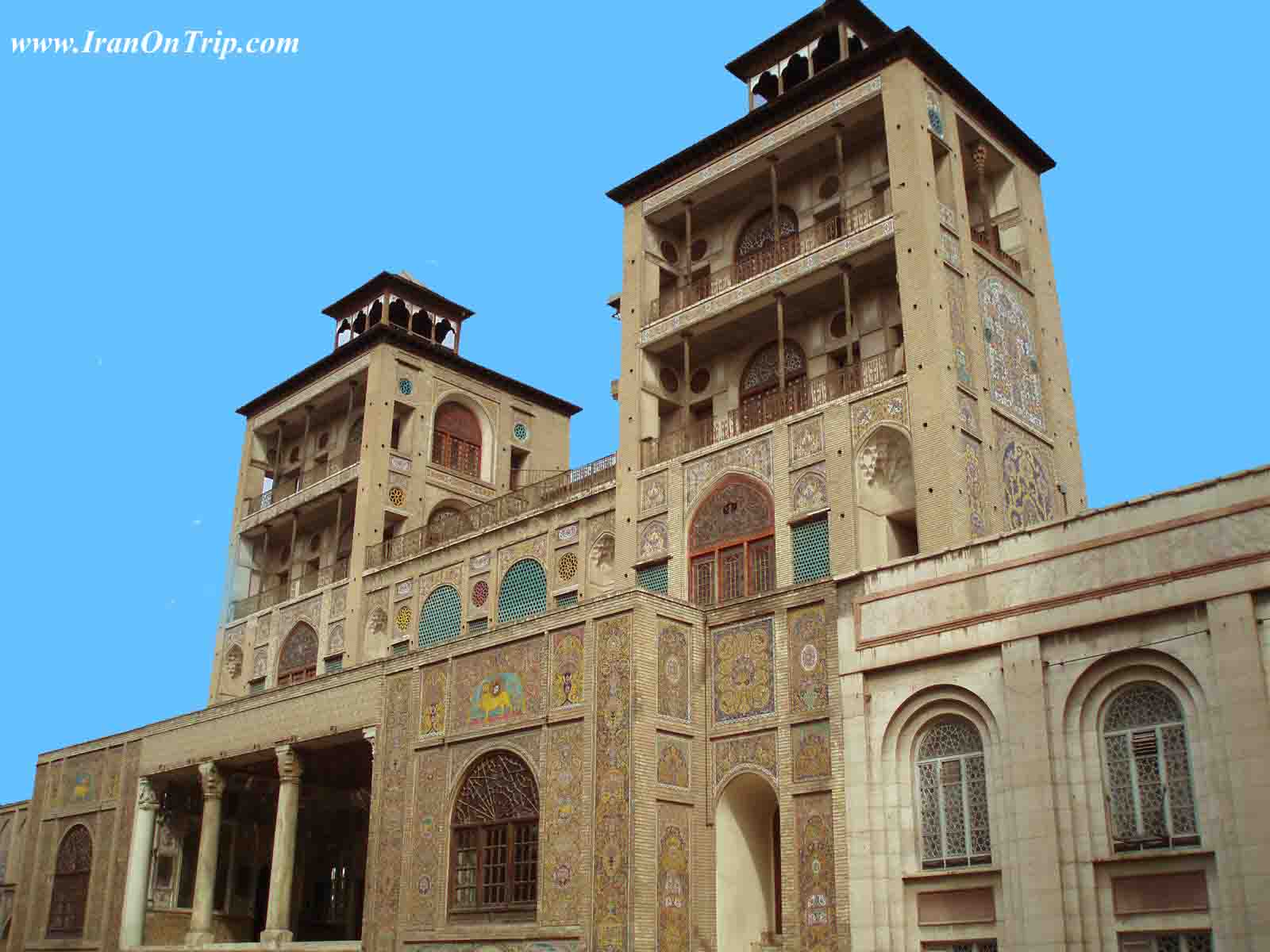
Shams-ol-Emareh (Edifice of the Sun) is the most stunning structures of the Golestan Palace.
The idea of building a tall structure came to Nasser-ol-Din Shah before his first European and from pictorial images of European buildings. The Monarch wanted a structure from which he could have panoramic views of the city.
Designed by Moayer-ol-Mamalek, construction on the Shams-ol-Emareh began in 1865 and was completed two years later. The architect was Master Ali Mohammad Kashi.The building has two identical towers. The exterior views have multiple arches, intricate tile work and ornate windows. This building is a fusion of Persian and European architecture.
Emarat Badgir
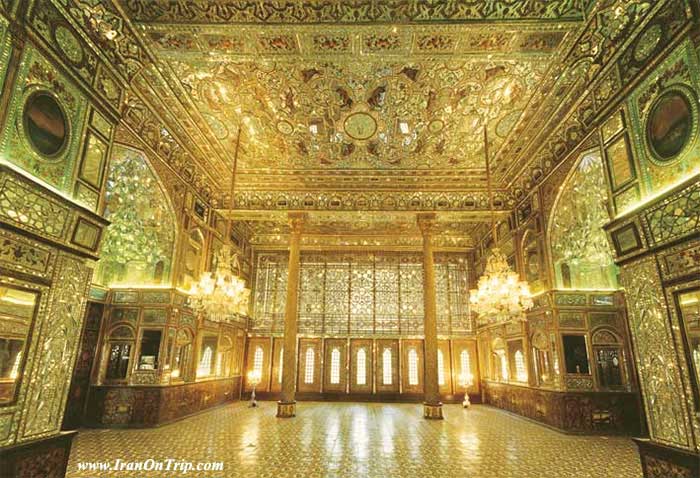
Emarat Badgir (Building of the Wind Towers) was constructed during the reign of Fath Ali Shah (circa 1806). The building underwent major renovations, including structural changes, during the reign of Nasser-ol-Din Shah. A watercolor rendering by Mahmood Khan Malek-ol-Shoara depicts the original structure prior to renovations,.
The building is flanked by two rooms known as goshvar (earrings). There is a central room which boasts the finest stained glass window in Golestan Palace. Outside, there are four wind towers of blue, yellow and black glazed tiles and a golden cupola. The wind towers are constructed to allow the cooling wind to move through the structure.
Talar Almas

Talar Almas (Hall of Diamonds) is located in the southern wing of Golestan Palace next to the Badgir Building. It is called Hall of Diamonds because of the exceptional Mirrorwork inside the building.
The construction of this hall dates to the time of Fath Ali Shah (circa1806). Nasser-ol-Din Shah renovated this hall changing its appearance and replacing the hall’s Ogival arches with Roman ones. He also ordered the walls covered with wallpaper imported from Europe. As the basic structure dates back to the time of Fath Ali Shah, it is only. It is only apt that this hall should be devoted to the exhibition of art and handicrafts from that period.
Abyaze Palace
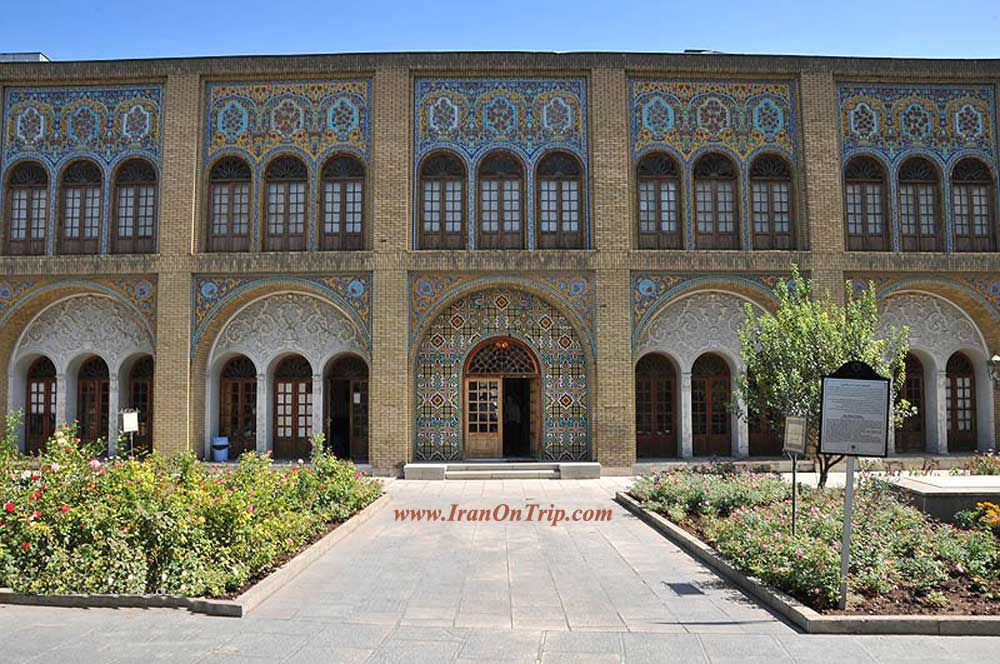
The Ottoman king, Sultan Abdoulhamid, send precious gifts to Nasser-ol-Din Shah. Reportedly, these gifts were copious and enough to fill a castle. The Qajar monarch was delighted with these gifts. He decided to build an exhibit hall worthy of these gifts within the confines of Golestan Palace. It is believed that Nasser-ol-Din Shah, himself, designed the structure, with a central hall large enough to house the carpet that was sent by Sultan Abdoulhamid.
Completed in 1883, the Abyaze (White) Palace now houses one of the most interesting ethological museums in Iran. There is a colorful exhibition of tradition Iranian costumes, as well as a folk art exhibition
In its present state, Golestan Palace is the result of roughly 400 years construction and renovations. The buildings at the contemporary location each have a unique history.
On October 11, 2005 the Cultural Heritage Organization of Iran submitted the palace to the UNESCO for inclusion into the World Heritage List in 2007. On June 23, 2013 it was proclaimed as world heritage site during the UNESCO meeting in Phnom Penh.
The Kushk of Shams-ol-Emareh was built Ustad Muhammad-ali Kashi in 1867CE.
Golestan Palace is currently operated by the Cultural Heritage Organization of Iran.
.....
.....
.....

.jpg)



























